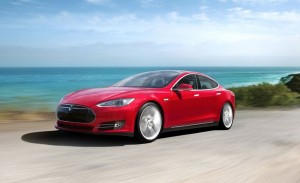
Tesla delivered its first eight cars in China today. Building the vehicles in China is a possibility in the future, according to CEO Elon Musk.
Tesla Motors has launched what could become its biggest gamble yet, delivering its first cars in China and hinting at plans to produce cars in the booming Asian nation.
The Silicon Valley start-up is already the second best-selling producer of battery-electric vehicles in the U.S. and has already launched sales of its Model S in Europe, but it is betting its timing is right to tap into burgeoning demand in China where the government is desperately pushing for a shift to battery power as a way to reduce the country’s endemic smog problems.
Tesla today delivered its first eight Model S sedans to Chinese customers, CEO Elon Musk telling reporting he hoped the maker could sell 5,000 of the vehicles in China this year, though he quickly cautioned the number is “just a guess.”
“I do think that’s probably a good number. Maybe it will be higher,” said Musk. “I don’t honestly know. Thus far the response has been very positive.”
That would be a significant development considering the less-than-stellar response Tesla has so far received in Europe where analysts say demand has been moderately good but not nearly as solid as the company appears to have anticipated.
China could be an especially fertile market, however, and for a variety of reasons.
For one thing, the Beijing government has been desperately struggling to find ways to reduce smog problems in the country’s major cities. The capital itself has exceeded all-time records for smog over the last year and, like a growing number of other Chinese cities, has implemented registration limits to slow the number of new vehicles being added each month. But those restrictions generally are waived for battery-electric vehicles.
That has prompted a number of manufacturers to add battery models to their line-up. Daimler AG, for one, is showing the Denza NEV concept vehicle at this week’s Beijing Motor Show, a prototype it developed in cooperation with BYD, a Chinese domestic battery-car manufacturer. Meanwhile, Volkswagen AG officials announced at the Beijing show plans to invest $27 billion in battery-based vehicle development.
Meanwhile, China’s demand for high-line vehicles is booming and it is soon expected to become the world’s largest luxury car market. The Model S is currently priced at around $115,000 in China, compared to a base of $70,000 in the U.S. Import vehicles face hefty tariffs, so Tesla is apparently giving serious thought to following the lead of key luxury rivals by producing locally, sidestepping such duties.
“At some point in the next three or four years we’ll be establishing local manufacturing in China,” Musk told reporters in Beijing, calling China “very important to the future of Tesla.”
Despite the Chinese government’s push for battery propulsion, industry analysts there note that sales have grown far slower than projected. According to trade organization figures, a total of only 17,600 plug-based vehicles – including both pure battery-electric vehicles and plug-in hybrids – were sold there in 2013, a year-over-year increase of 37.9%.
(GM asks bankruptcy court to dismiss non-injury lawsuits. For more, Click Here.)
By comparison, Nissan sold 22,610 Leaf battery-electric cars in the U.S. in 2013, while General Motors moved 23,094 of its Chevrolet Volt plug-in hybrids.
A major part of the problem for China’s battery-car push is the reality that the vast majority of its urban dwellers live in large apartment and condominium complexes, few of them equipped with charging stations.
(Click Here to check out VW’s possible plans for its little NMC Concept.)
As a result, “We’re going to make a big investment in China in terms of charging infrastructure,” said Musk, adding that, “My instructions to the team are to spend money as fast as they can spend it without wasting it,” on both charging stations and service facilities.
(To see Bugatti’s latest Veyron super car, Click Here.)
Part of the process includes setting up the same sort of nationwide Supercharger network Tesla is now rapidly expanding across the U.S. – where it has set a goal of having a Supercharger within 80 to 100 miles of every Model S owner. Those stations, however, are seen more as a way to permit American drivers to use the battery sedans for long, cross-country drives, rather than for everyday charging. It remains to be seen how Tesla will set up its Chinese charging system.
Tesla’s launch in China was actually pushed back by a number of months, Musk explaining on Tuesday that the company first wanted to make sure that any of its new customers would have access to charging facilities.
